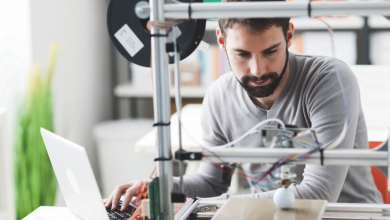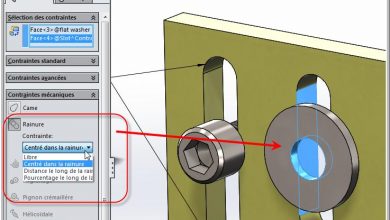
Yesterday, I had the pleasure of joining hundreds of additive manufacturing enthusiasts at Dassault Systèmes’ very first additive manufacturing seminar, as part of the SCIENCE in the Age of Experience event held May 15-18. The objective of the event was to bring together experts and representatives from the world of additive manufacturing (AM), in order to share knowledge on the latest innovations, to jointly respond to the challenges of the sector and to generate ideas to accelerate the adoption and advancement of technology.
Many leaders from industry, government and academia responded. First, Derek Luther, engineer at Adidas, presented the role of 3D printing in creating the company’s first 3D printed running shoe, the FutureCraft 4D, which features a very complex lattice structure. You can discover it in the video below.
The German company has partnered with the tech company Carbon, which uses an FA process called Direct Light Synthesis. With additive manufacturing, Derek Luther says engineers and designers have more freedom in design, can iterate faster due to the increased speed of getting parts, and now have the ability to create each cell of the truss structure according to customer’s requirements. The company plans to ship 5,000 shoes by the end of the year, with an acceleration in 2018.
As for John Vickers, from NASA’s Marshall Flight Center, he underlined the major role of the FA in the NASA missions, in particular the Mars mission. Since additional supplies and redundant parts cannot be brought along due to the astronomical costs of the payload in space navigation, the ability to create parts through on-board 3D printing is mission critical.
Troy Hartwig from Kansas City National Security Campus (NSC) explained how AM has dramatically increased the ability of designers to innovate. The technique has changed the field of design possibilities, introducing new shapes that were not possible before, due to the constraints of traditional manufacturing methods. “You discover and innovate when you stop thinking about design constraints and can add complexity to your designs, without the added costs that usually come with it. “
The NSC uses 3D printing for prototyping and material characterization, alongside tooling and equipment for the different systems.
Jerry Feldmiller fromOrbital ATK stressed the importance of industry participation in designing the hardware, software and materials of tomorrow for additive manufacturing. Jerry Feldmiller’s company has been heavily involved in additive manufacturing, beta testing vehicle components through Statasys AM machines. He believes that this work has uncovered many areas of research at Orbital. He emphasizes that it is crucial that internal user groups in companies share key AM information and optimize machine utilization across teams and divisions. Jerry Feldmiller also believes that external user groups should actively develop and share design best practices for 3D printing. As for universities, they need to get involved in STEM activities to bridge the growing skills gap, citing the 2 million jobs that will go unfilled in the next decade.

Tim Simpson, professor at the Penn State University spoke about the challenges and research opportunities in additive manufacturing. He said FA has drastically changed the way we approach design. With the help of FA engineers, very light components can be designed using internal truss structures, which was not possible with traditional manufacturing methods. He gave the example of a 3D printed titanium hip prosthesis, which can now go from conception to FDA approval in just 14 months. In addition, thanks to the use of AF, these prostheses will one day be able to be completely personalized for the body of each patient.
Jack Rome from The Aerospace Corporation mentioned process simulation for the development of FA parts for space applications. It is often thought that simulation is used to analyze individual components or assemblies of components. However, to validate parts for space applications, the AM process must also be validated. When designing for additive manufacturing, material variability should be taken into account. He also stressed the need for FA industry standards, in addition to the efforts of individual companies, such as ASME.
Still on the subject of standardization, Lyle Levine of the National Institute of Standards and Technology (NIST) focused on additive manufacturing of metals. Part of the reason why metallic AF is not more prevalent, Lyle Levine says, is because of its inherent complexities. The cooling rates of various alloys vary widely, making the nonlinear behavior of the material more unpredictable. To create metal parts with AM, users must use simulation to “fill in the gaps”. His company works with a multi-pillar approach to facilitate adoption by industry, and has created a “knowledge box” of tools to use for AM and an “engineering box” with standards, guidelines. best practices, validation methods and evaluation tests.
Jack Beuth, professor at Carnegie Mellon University spoke on the challenges of AM for the sector. According to him, although few companies currently use FA production, the technology nonetheless has a significant impact on product development. Often, companies start with service desks as well as internal tools and prototyping as the first step in additive manufacturing. He quoted GE as a company at the forefront of the use of advanced digital manufacturing and additive manufacturing. The company is currently using FA to produce numerous subsystems for jet engines. GE estimates that by using AM, it is possible to reduce the number of parts for its new jet engines by 800. In addition, around 30% of the parts for its new gas turbine engine are 3D printed.

For more information on how the different types of additive manufacturing work, articles and on-demand webinars, see the new section of the SOLIDWORKS website at the address http://www.solidworks.com/am.


